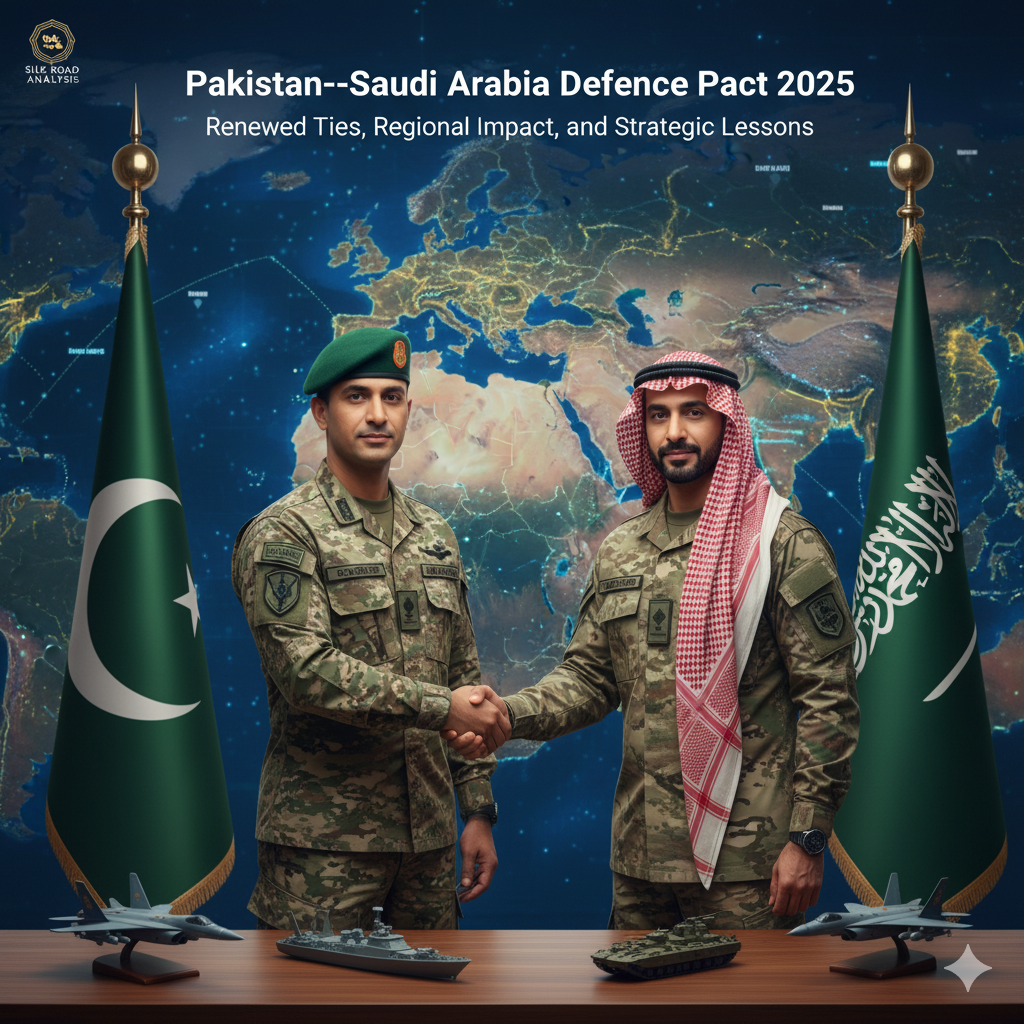Introduction
The year 2025 marks a significant milestone in Pakistan–Saudi Arabia relations as both nations signed a renewed defence pact. After years of strained ties and shifting alliances, Islamabad and Riyadh have decided to reaffirm their strategic partnership, signalling that traditional bonds outweigh temporary divergences.
The most striking element of this pact is its NATO-style clause of mutual defence, stating that “any aggression against either country shall be considered aggression against both.” This commitment has sent ripples across South Asia and the Middle East, with different stakeholders interpreting it through their own security lenses.
From Strains to Reconciliation: A Timeline of Divergence
The 2015–2023 period was marked by repeated tensions:
- Yemen Conflict (2015): Pakistan’s refusal to send troops to Yemen, despite earlier promises, upset Riyadh.
- Kuala Lumpur Summit (2019): Islamabad’s brief alignment with an Iran–Turkiye–Malaysia bloc was seen as an affront by Crown Prince Mohammed bin Salman (MBS).
- Imran Khan–MBS Tensions: Personal strains between leaders worsened mistrust.
- India–Saudi Pivot: Riyadh deepened ties with New Delhi, launching the India–Middle East Economic Corridor (IMEC, 2023) with the US and UAE, leaving Pakistan excluded.
Meanwhile, Pakistan relied more on China through CPEC, expanded its partnerships with Turkiye and Azerbaijan, and sought new connectivity to Central Asia.
Saudi Arabia, on the other hand, recalibrated by normalizing ties with Iran (2023 Beijing deal), improving relations with Turkiye, and engaging Russia — further highlighting the rift with Islamabad.
The Defence Pact of 2025: What’s New?
Although not the first defence-related agreement, this pact introduces a crucial clause:
“Any aggression against either country shall be considered an aggression against both.”
Key dimensions:
- Pakistan’s Perspective: A deterrent message toward India.
- Saudi’s Perspective: Security insurance against Houthis in Yemen and potential threats involving Israel.
- Joint Military Cooperation: Expanded training programs, counter-terrorism collaboration, and talks on joint defence production.
This makes the agreement both symbolic and strategic, with each nation interpreting its utility differently.
Facts and Figures: Why This Pact Matters
- Saudi Arabia’s Defence Spending (2024): $75 billion (5th largest globally, SIPRI).
- Pakistan’s Defence Budget (2024): $10.3 billion (~3.5% of GDP).
- Military Manpower: Pakistan has ~640,000 active troops; Saudi Arabia ~227,000.
- Remittances: Pakistani workers in Saudi Arabia sent back $7.1 billion in FY2024 — the single largest source of foreign remittances.
- Trade and Investment: Saudi commitments of $25 billion in Pakistan (energy, mining, Gwadar refinery, Reko Diq).
These numbers show that the pact is not only about military cooperation, but also economic interdependence.
India’s Position: Strategic Balancing by Riyadh
While some in Pakistan see this pact as a tilt against India, the reality is more nuanced:
- India–Saudi Trade: Exceeded $53 billion in 2024, making New Delhi a vital economic partner under Vision 2030.
- Mediation Role: In a potential India–Pakistan conflict, Riyadh is more likely to mediate, as it did in 2020, than to militarily intervene.
- Strategic Pragmatism: Saudi Arabia will not jeopardize its partnership with India for Islamabad.
Thus, the pact signals support, not exclusivity.
Beyond the “Islamic NATO” Illusion
The renewed pact has fueled speculation about reviving an “Islamic NATO.” However, this remains unrealistic:
- Failed Precedents: The 2015 Islamic Military Coalition lacked coherence.
- Diverging Agendas: Iran, Turkiye, Pakistan, and Saudi Arabia compete for influence.
- Saudi Priorities: Vision 2030 focuses on economic diversification, not ideological alliances.
In reality, talk of an Islamic bloc is driven more by Iranian aspirations and ideological rhetoric than by pragmatic Gulf policy.
Strategic Lessons for Pakistan
- Economic Fragility Weakens Diplomacy
- Pakistan’s GDP growth (2020–24) averaged 2.4%, compared to India’s 6.3%.
- Reliance on Saudi bailouts reduces Islamabad’s leverage.
- Go Beyond Transactional Ties
- Pakistan must reposition its relationship as a two-way partnership, not a lifeline during crises.
- Capitalize on Vision 2030
- Opportunities exist in energy, agriculture, defence co-production, and logistics.
- Balance Multiple Axes
- With China (CPEC), Saudi Arabia, Turkiye, and Iran in play, Pakistan must carefully avoid zero-sum alignments.
Regional Impact
- Iran Factor Neutralized: With Saudi–Iran détente, Pakistan no longer faces the “choose one side” dilemma.
- US and China Interests: Washington supports stability in the Gulf; Beijing views stronger Saudi–Pakistan ties as beneficial to BRI security.
- Gulf Security Architecture: The pact contributes to a broader effort to shield the region from instability, while projecting Riyadh as a central power broker.
FAQs
Q1: Will Saudi Arabia militarily support Pakistan against India?
Unlikely. Riyadh’s India partnership is too valuable. At most, Saudi Arabia would mediate diplomatically.
Q2: What does Pakistan gain beyond military guarantees?
Access to Saudi investments, defence co-production opportunities, and reinforced remittance flows.
Q3: Is this pact a step toward an “Islamic NATO”?
No. The idea lacks political will, unity, and practicality.
Conclusion
The Pakistan–Saudi Arabia Defence Pact 2025 is a landmark agreement that restores mutual trust after years of estrangement. While it does not herald a pan-Islamic military alliance, it reaffirms bilateral commitments, enhances joint defence, and strengthens economic ties.
For Pakistan, the key takeaway is that true national strength comes from economic resilience, not only military partnerships. For Saudi Arabia, it reflects a pragmatic balancing strategy — maintaining ties with Pakistan, India, and Iran simultaneously.
In an era of shifting global alignments, one message stands out: the Pakistan–Saudi friendship remains durable, pragmatic, and strategically relevant.







